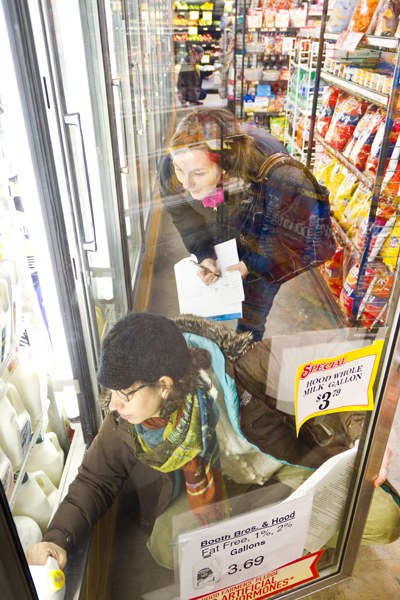The Consumption Team hopes to document current and potential community-level constraints and identify opportunities for improving access to regionally produced healthy food for people in low-income communities in the Northeast.
What is the focus of this research area?

Consumption Team member Linda Berlin and University of Vermont student Marie Limoges conduct a store inventory of the project's market basket items. Credit: Joshua Brown, UVM, 2013.
The goal of the Consumption Team is to understand food access in our eight study locations in the Northeast. We are conducting focus groups and shopper intercept surveys to understand purchasing habits as well as the opportunities and barriers to accessing healthy foods. We also are evaluating several retail stores and their current supply of our market basket foods. Assessing how the current food environment serves low-income communities will help us identify opportunities to improve these communities' access to regionally produced healthy foods. We will continue to interact with the same communities and stores for the duration of the project.
How does this research fit into the overall project?
This research fits into the overall project goal of determining whether regional supply chains can provide healthy foods to low-income consumers at affordable prices by identifying opportunities to improve healthy food access at the retail level. Our consumption research links to the distribution and production research in several ways:
- In an effort to foster community engagement at each location, we incorporate information on production capacity and supply chains into our focus group sessions. This information is assembled by the production and distribution research teams.
- Our assessment of organizational and operational dynamics affecting consumer access to healthy food will occur in conjunction with the distribution team's supply chain characterizations. We focus on food retail outlets, such as supermarkets and corner stores, to link to supply chain analyses and investigate the potential for increasing local and regional food sources in the Northeast.
What are the research activities?
This research engages community members, undergraduate and graduate students in primary data collection throughout the region. Data collectors are documenting constraints to healthy food access from both the retailer and consumer perspectives. Consumption research activities include:
- Determining the type, quality and cost of certain foods available to customers in selected retail markets throughout the region, tracking changing availability of healthier options and amounts of locally and regionally sourced foods in a "market basket" comprising fruits, vegetables, beef, milk and bread;
- Conducting focus groups to capture community members' perspectives and insights with respect to all facets of this integrated project;
- Conducting brief individual shopper (intercept) surveys at retail markets to determine purchasing habits, access to food stores, perceived quality of foods available, and food assistance program use by shoppers in the eighteen food stores across the nine study locations;
- Using secondary data and modeling to assess how food retailers' location decisions and customer characteristics interact to result in limited food access for low-income individuals across the Northeast; and
- Investigating two retail outlets (e.g., supermarkets and corner stores) within each location to determine if more regionally produced healthy food could be made available to low-income consumers.

